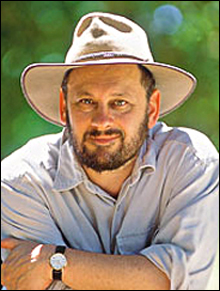
Tim Flannery
|
"Some time in this century, the day will arrive when the human influence on the climate will overwhelm all natural factors.” So writes the Australian scientist and conservationist in The Weathermakers (Atlantic Monthly Press). The book weaves a detailed, accessible, and convincing argument for how human activity is causing global temperatures to rise. Flannery does more than tell us that climate change is happening: he shows us where, why, and for how long it has been occurring. In other words, he makes an urgent case — one that has created waves among policymakers and politicians alike. In an e-mail interview with the Phoenix, the former Harvard University professor shares what made him start to pay attention — and why the rest of us should too.Deirdre Fulton: You used to be skeptical about global warming. What changed?
Tim Flannery: I changed my mind because I finally made time to read the scientific literature on the topic. Before that, I had read around the issue, but never fully immersed myself in it. I fear that [those who remain skeptical today are] either biased by alliance to an industry or ideology, ignorant of the latest science, or afraid of facing the truth.
DF: How would you assess the Bush administration’s actions on global warming?
TF: The worst in the world, with the possible exception of Australia.
DF: Your book offers many concrete examples of how climate change is already affecting our world. Can you mention some of the most compelling?
TF: The melting of the Arctic ice cap is occurring at the rate of eight percent per decade, and the Alaskan and Canadian tundra are warming swiftly. Already Inuit villages are being abandoned and polar-bear populations are coming under stress. If you want to see some of the worst impacts of climate change to date, ask an Inuit.
DF: What examples of climate change have you witnessed personally?
TF: I live in Australia and have spent most of my scientific life working in New Guinea. There I’ve seen glaciers retract from the highest mountains, alpine grasslands be taken over by forest, and forest fires destroy pristine rain forest. All of this has occurred as a result of global warming and our changing climate.
DF: Where could we be in 50 years, if nothing changes?
TF: Within 50 years we could see a destabilization of Earth’s climate system. This means that everything — from the incidence of storms, to sea level, to rainfall and heat waves — could change.
DF: Are mild winters, or weeks of rain, the result of climate change?
TF: It depends on where they are. In Alaska the trend is already undeniable. Elsewhere, the changes are more subtle, and of course there is a lot of natural variability in the weather. But one thing is for sure: you’ll see a lot more changes in climate as our air pollution continues to take effect.
DF: What needs to happen in order to shift public opinion on climate change?
TF: Good-quality information. But public opinion is already shifting, I think. Whether political opinion will ever shift is another matter. But that is what elections are for.
DF: What do you think of the Kyoto Protocol?
TF: Kyoto is the only international treaty on climate change that we have, and thankfully China and India are signatories. They will hopefully take on part of the burden of reducing emissions in its second phase, which begins in 2012. But for this to happen, Australia and the US will need to stop being free riders and ratify.
DF: How would you assess the development of clean-energy alternatives?
TF: Solar, wind, and other less-emissions-intense technologies are already well developed. What’s needed now are strategies to get them to market. While the CO2 polluters do not pay, their energy will be cheaper, and they will stymie uptake of clean energy. The best mechanism is a broad-based, revenue-neutral carbon tax — i.e., tax the polluters and give everyone else an income-tax break to the equivalent amount. Of course, it has moved more slowly than it should. We can speed it up by making the polluter pay.
DF: Do you consider geothermal energy to be part of the solution?
TF: Geothermal energy has enormous potential. It was Nikolai Tesla who said that there’s a lot of heat under our feet, and if we could tap it, we would have a limitless source of energy.
DF: How do you recommend that people go about reducing their carbon footprint?
TF: Sell the SUV and buy a smaller car. Buy a solar hot-water system and energy-efficient goods. There are hundreds of ways of making a difference, so go online and discover what works best in your area.